Electric Currents
When there is a flow of charge we say that there is an electric current. So, electric current is the flow of charge. To make an electric charge to move, there must be an electric force on the charge. To have an electric force, we need an electric field. If there is an electric field, then there is a potential difference. Since potential difference or voltage is a scalar quantity (note that electric field is a vector), it is desirable to work with potential difference than electric field. So, when dealing with current, we will use potential difference rather than electric field.Electric current, $I$ is defined as the rate of flow of electric charge through a cross section of a conductor such as wires,
$I=\dfrac{\Delta Q}{\Delta t}$
where $\Delta Q$ is the amount of charge passes through a cross sectional region of a conductor in a time interval $\Delta t$.An electric current can flow if there is a continuous conducting path called complete circuit. Current cannot flow in a broken circuit.
From the definition of current, we see that the unit of current is $C/s$, this unit we call ampere $A$. Ampere is the SI unit of electric current.
Electric battery
To have a current in a conductor such as a metal wire, there should be a potential difference or voltage across the conductor. Electric batteries are the source of potential difference. An electric battery has a positive terminal and a negative terminal, and there exists a potential difference between the terminals. So, when a conductor is connected between the terminals of a battery, the electrons in the conductor move, and we have a current in the conductor. In a battery, the positive terminal is at higher potential and the negative terminal is at lower potential.The following symbol is used to represent an electric battery.

The longer vertical line is the positive terminal and the shorter one is the negative terminal.
Conventional current and electron current
In solid conductors such as metal wires, current is the result of flow of electrons. Since the electrons move from lower potential to higher potential, in an electric circuit, an electron move from the negative terminal to the positive terminal of the battery.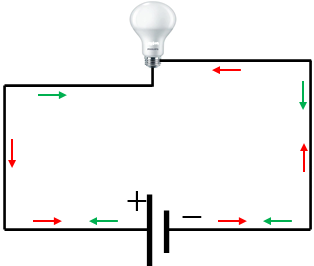
Current in gases and in liquids
In gases and in liquids, current is due to the flow of positive and negative ions. An ion is an atom or a group of atoms that lacked or gained one or more electrons. There are positive ions and negative ions. An atom that lacked electron (s) is called a positive ion and an atom that gained electron (s) is called negative ion. Negative ions move opposite to the positive ions in an electric field.Ohm's law
In 1827, Georg Simon Ohm, found that a voltage, applied across a conductor produces a current, which is proportional to the voltage. i.e., voltage, $V$ is proportional to the current, $I$:$V \propto I$
or$V=IR$
The proportionality constant, $R$ is the resistance of the of the wire.The above equation is called Ohm's law.
According to Ohm's law, more the resistance a conductor has, less current can flow through the conductor for a given voltage. So, the resistance of a conductor impedes the flow of electric charge.
If a conductor obey's Ohms law, you will get a straight line for an $I$ vs $V$ graph.
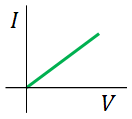
Conductors that obey the Ohm's law are called ohmic. Metal conductors are ohmic.
Conductors which do not follow Ohm's law are called nonohmic. The resistance of a nonohmic conductor is not constant but it varies with the voltage. So, for a nonohmic conductor, the $I$ vs $V$ graph is not a straight line.
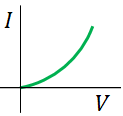
Resistivity
Resistance of a cylindrical conductor such as a wire depends on the length and the area of cross section of the conductor. The resistance of a wire of length $\ell$ and cross sectional area A is$R=\rho \dfrac{\ell}{A}$
where $\rho$ is called the resistivity of the material of the wire. It depends on the material not on the length or the area. From the above equation, you see that larger the diameter of a wire, smaller the resistance. And also, shorter the wire, smaller the resistance.
Electric bulbs and all other electric devices have some resistance. The wires we use to connect the devices has very low resistance and they only have very little impact on the flow of current.
Resistors: A resistor is an electrical component that is used to control the electric current in an electric device.
Electric power
In electric devices, electric energy is transformed into other forms of energy. The energy transformed in an electric device per unit time is the power rating of the device. If the potential difference or voltage across a device is $V$,and if a charge of $Q$ moves across the device, then the energy transformed is the change in potential energy of the charge:i.e., $\Delta PE = Q V$
So the power of the device is
$P=\dfrac{\Delta PE}{t}$
$=\dfrac{QV}{t}$
$Q/t$ is nothing but the current, $I$ flows through the device. Therefore,
$P=IV$
The power transformed in an electric device is delivered by an electric source such as a battery.In resistors electric energy is transformed into thermal energy. By using Ohm's law, we can write, the power or rate of energy transformed in a resistor of resistance $R$ is
$P=I^2R$
or$P=\dfrac{V^2}{R}$
Household circuits
In households, if the current through a wire is large, it generates more thermal energy, which may result in fire. A thicker wire can carry more current than a thin wire as it has less resistance. All the wires have a limit to carry a current. If a wire carries more current than its limit, we say that it is overloaded. To prevent overloading, fuses and circuit breakers are being used.Alternating current (ac)
There are two types of current, direct current (dc) and alternating current (ac). Current from an electric battery is direct current, because the current flows in one direction from positive to the negative terminal of the battery. But an alternating current reverses its direction periodically. Current generated by electric generators in electric power plants are alternating current. Electricity supplied to the households is ac. Since a direct current flows in one direction, it does not change with time. So if you draw a current vs time graph for a dc, you will get a horizontal line.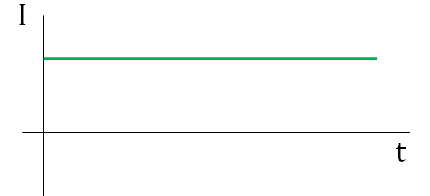
Since an alternating current reveres its direction periodically, the current changes continuously with time. In an ac, the current, $I$ changes with time, $t$ according to the following equation,
$I=I_0 \sin \omega t$
where $I_0$ is the peak current and $\omega=2\pi f$, is the angular frequency of the current. $f$ is the frequency of oscillation of the current, which is the number of times the current changes its direction per second. In the US, the frequency of the alternating current supplied to the household is 60 Hz.
The typical graph of an alternating current vs time is sinusoidal and is given below.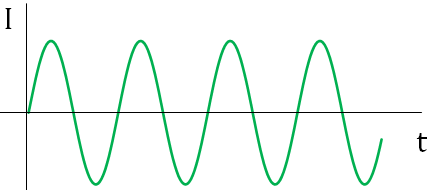
Ohm's law is applicable to both direct and alternating current. If an alternating current passes through an electric device or a resistor of resistance, $R$, then the voltage across the device or the resistor is
$V=IR=I_0R \sin\omega t$
or$V=V_0 \sin \omega t$
where $V_0=I_0R$ is the peak voltage.
Since the ac voltage or current continuously changes with time, they have different values at different times. So, it is desirable to have a single value to represent the voltage or the current. We use the root mean square (rms) value of the voltage or the current as the single number to represent an ac voltage or an ac current. The rms values can be determined from the voltage and the current equations. The rms voltage and the rms current of an ac are
$V_{rms}=V_0/ \sqrt 2$
$I_{rms}=I_0/ \sqrt 2$
When you say 120 V ac electricity at the household sockets, actually you mean the rms voltage. When we calculate the power of an electric device that uses an ac, we use the rms values of the voltage and the current. That is the power rating of an electric device in an ac circuit is
$P_{rms}=V_{rms}I_{rms}$
